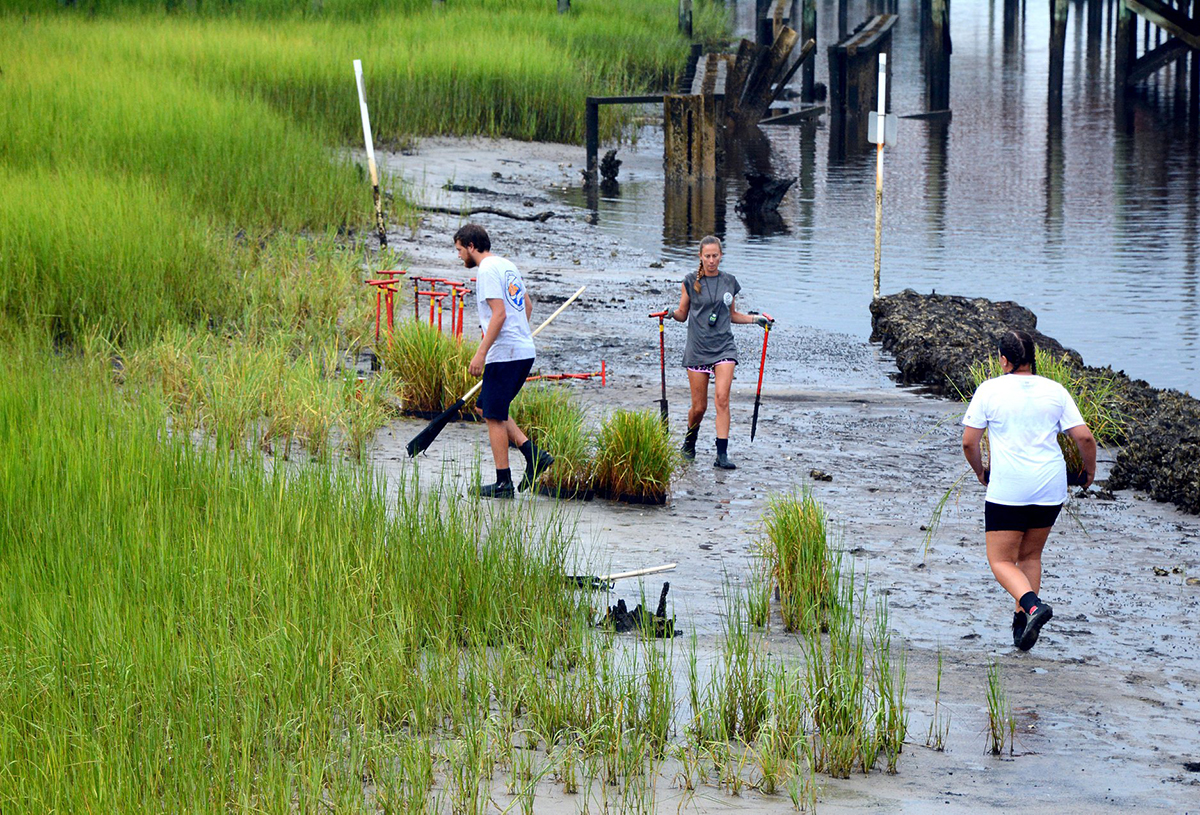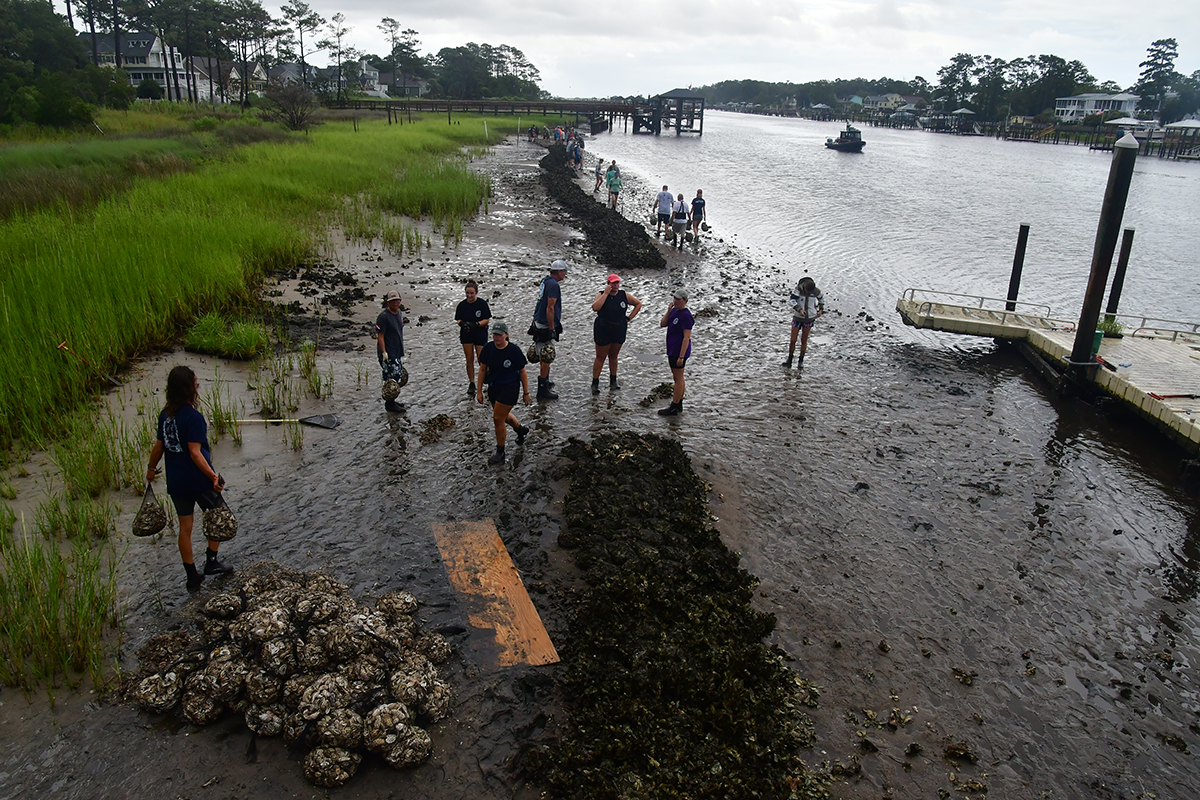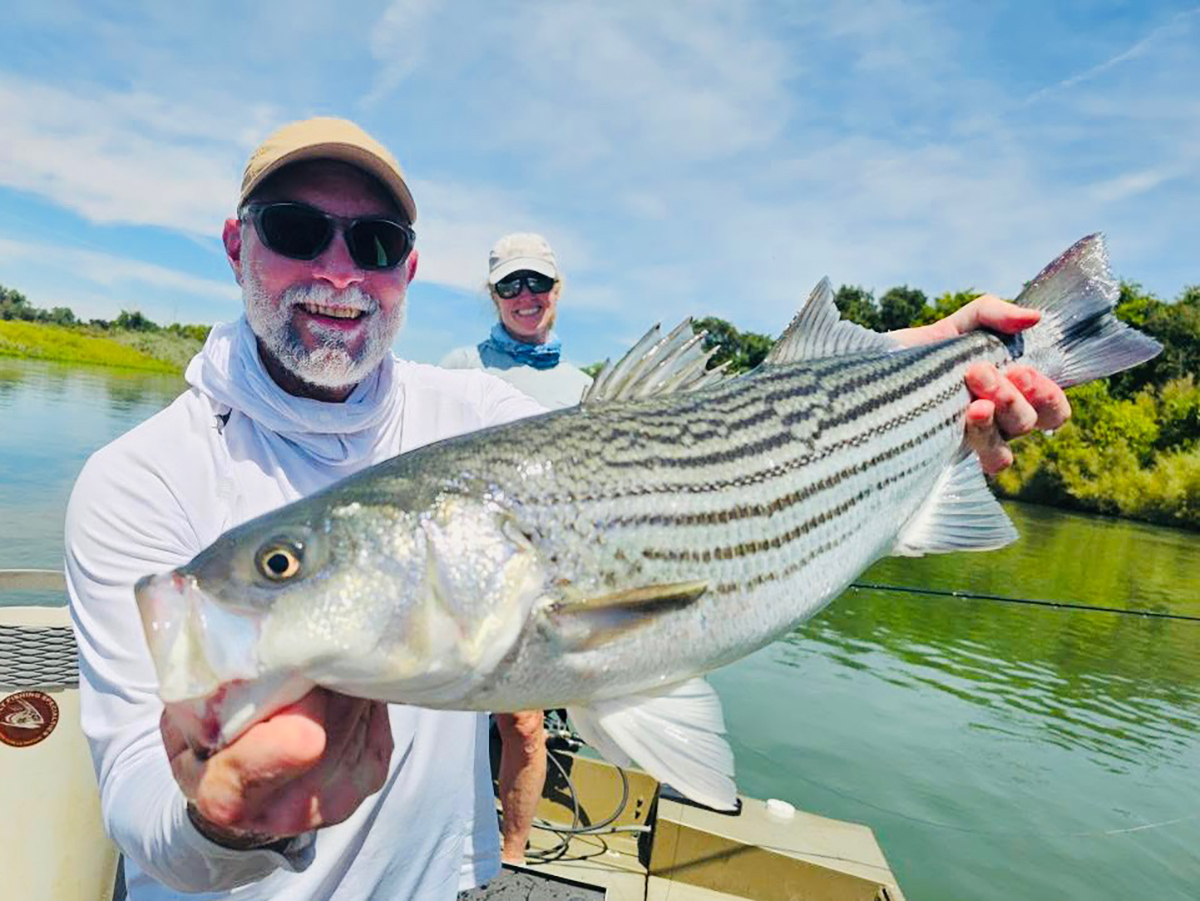
ST. JAMES — Years ago, the phrase “living shoreline” wasn’t well known in North Carolina outside of, say, the circles of coastal scientists and researchers.
“I don’t recall that at the time we used the term ‘living shoreline’ as much as we do today,” chuckled Taylor Ryan of St. James in Brunswick County. He’s project leader and founder of the community group, The Royal Order of the Honorary St. James Oysters.
Supporter Spotlight
When Ryan went to the University of North Carolina Wilmington and the North Carolina Coastal Federation, which publishes Coastal Review, to ask how his town could reduce erosion along its waterfront park, he had no idea his request would result in a burgeoning, 16-years-and-counting relationship forged by a passion for education, research and resiliency.
The small, relatively young town of St. James in Brunswick County in August created an endowment fund at the university with a gift of $25,000 to support students’ work and research at the town’s living shoreline, officials announced last month.
UNCW has more than 2,000 funds that support an array of programs, but the St. James endowment is special because it was set up by the town.
“This is unique in that the town actually created the endowment fund,” said Lindsay Crighton, director of development of UNCW’s Division for University Advancement. “This is unique because it is pairing a town and the university in looking at coastal resiliency and looking at how a coastal university can partner with a coastal community and have such an impact in the region.”
It all started in the mid-2000s when Ryan attended a seminar about oysters — specifically, the value of an oyster.
Supporter Spotlight
A single oyster can clean between 40 to 50 gallons of water a day, Ryan learned. Their shells can be incorporated into a living shoreline, one that is built of natural materials to stabilize and protected a shore.
Such a project sounded like the right fit for the shoreline along St. James’ Waterway Park nestled along the Intracoastal Waterway.
Ryan went to St. James’ then-Mayor Shelley Lesher to ask for $5,000 to kickstart a living shoreline project at Waterway Park. Her answer was an immediate “yes.”
Fast forward through the permitting process, which was not a simple one, to the first build, one where UNCW students and their professors, Coastal Federation officials and 94 St. James residents worked together.
Since that first build, 9,000 bushels of shells have been placed along the shoreline and more than 27,000 plugs of Spartina grass have been planted, according to St. James Mayor Jean Toner.
The town’s website states that some 540 feet of shoreline has been restored and stabilized with plans to do another 2,360 feet.
“Every year, twice a year, we have students and staff join with our residents to work along our intracoastal shoreline to build up the oyster reefs,” Toner said. “It’s been an excellent project. We’ve learned a great deal from the staff and students. We’ve really enjoyed the partnership we have with them. This program, in particular, I’ve just never seen this much dedication.”
Their enthusiasm ultimately led to a natural collaboration between the town and university, one that reaches beyond the confines of St. James’ boundaries and affords college students a treasure trove of research opportunities.
Over the past year and a half, the university has been hosting presentations open to residents in the region.
Those presentations have included conversations about coastal habitats and the dynamics of living shoreline erosion, issues that are of general interest to the broader community.

“When we’re doing a build it’s not just a build, it’s also an outreach and education,” said Martin Posey, a professor and director of UNCW’s Center for Marine Science.
The benefits of the project have become multifaceted.
“That’s one of the great aspects of having this long-term study where we’ve been able to see over the 15 years how has it done as we are beginning to get more storm effects and sea level rise,” Posey said. “And, the endowment sort of solidifies this research can continue another 10 or 15 years. We’re not going to be here forever, but the endowment will help ensure that work continues and we’re able to continue to see how do these systems respond in the long term when they’re faced with these pressures of climate change.”
Posey and Troy Alphin, senior research associate at the center’s Benthic Ecology Laboratory, have been involved in St. James’ living shoreline from the get-go.
The town’s support has afforded a great opportunity for dozens and dozens of students, both graduate and undergraduate, they said.
“The classroom is good. The classroom tells you the facts and the figures and the labs give you some controlled approach. But, to actually get out there and do the research, to see how things don’t always work out the way you want them to work out, to see the fact that results can be fuzzy and you have to sort of figure out what’s happening, to learn the art of science is something that is absolutely critical that has to be done hands-on,” Posey said.
Kenneth Halanych, who took the helm in June as the UNCW center’s executive director, said the relationship between the town and the university has an even broader outreach.
“Engaging both the community and the young researches in science really helps build the trust in science from the community perspective,” Halanych said.
“One of the things we’ve had a huge problem with in this country, especially in the last little bit, is the trust in science and the trust in expertise has been greatly eroded. So, this is a chance for scientists to go and interact with the community, to interact with young researchers or young individuals and say, look, the science is critical in your everyday life,” he said. “This sort of activity I actually think is really important for helping people understand the importance of science and the scientific process. These types of partnerships between communities and universities and the involvement with students is critical for building a productive future.”
The St. James endowment will provide funds to continue the partnership at the university and support students’ work in the town.
“Our hope is eventually that other people in Brunswick County, people that are interested in coastal resiliency and marine biology and applied learning at UNCW that they will be interested in supporting this fund as well because we want other towns, communities, etcetera to look at this opportunity and think well maybe we could do this as well,” Crighton said. “As more support comes in we’re going to be able to do more work, not only in the town of St. James, but also in Brunswick County and expand the ability to have more applied learning opportunities for our students at UNCW, which is a big thing.”







